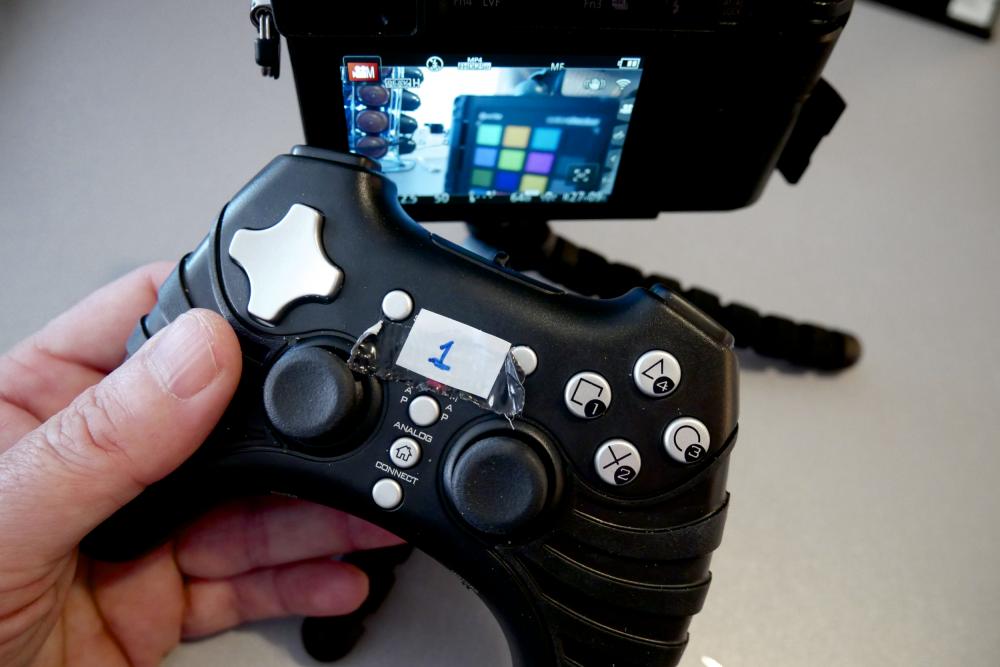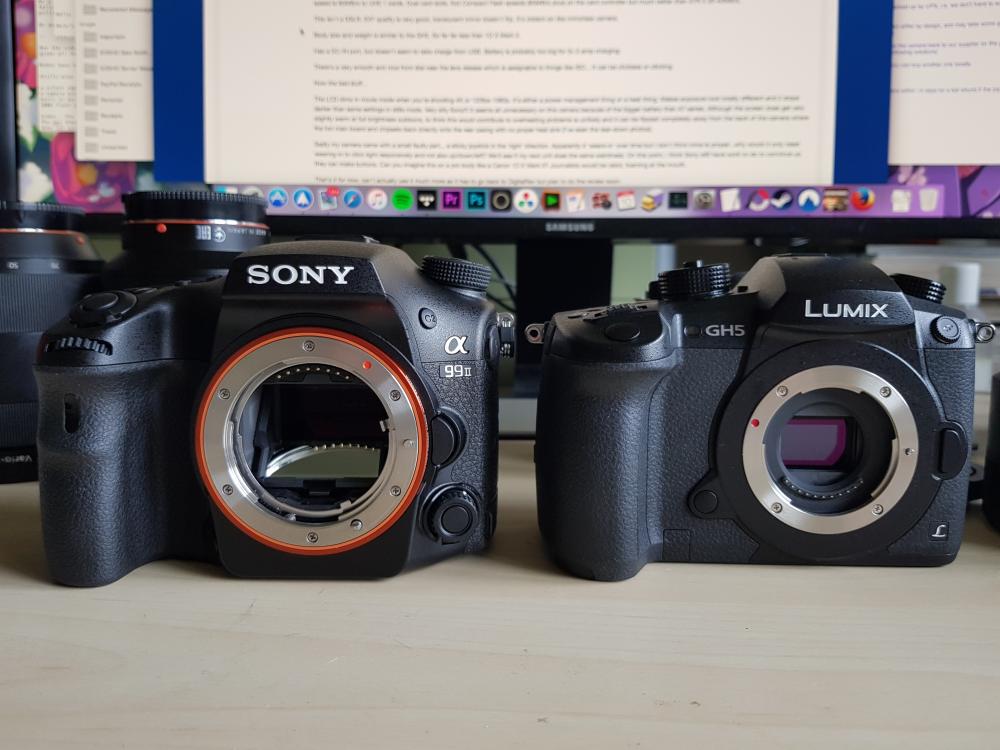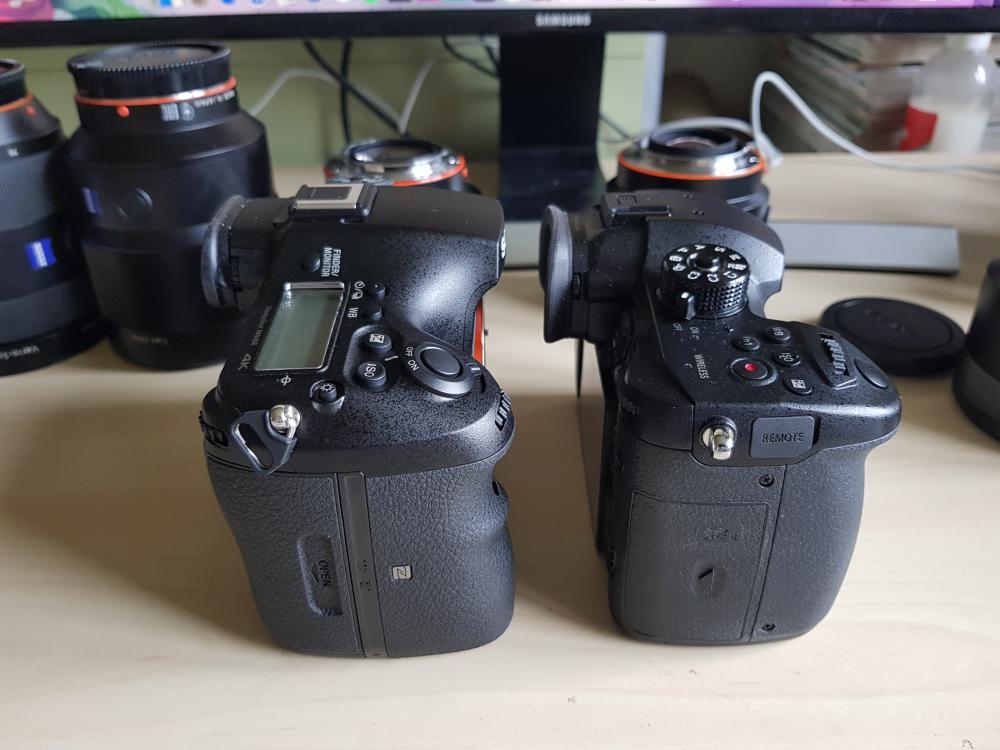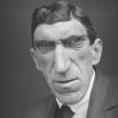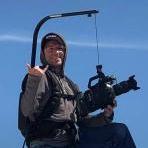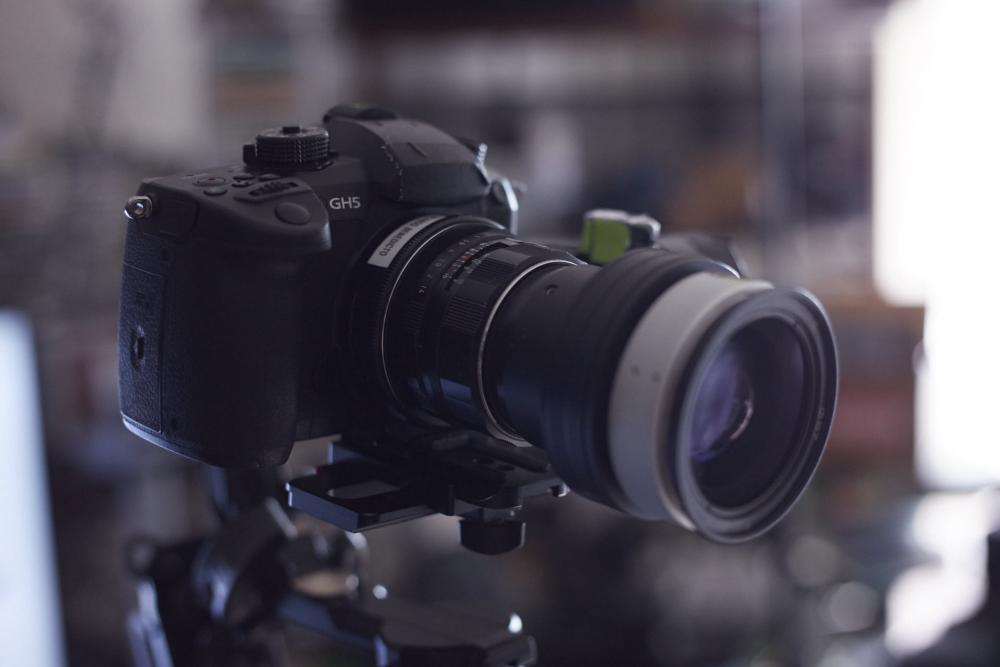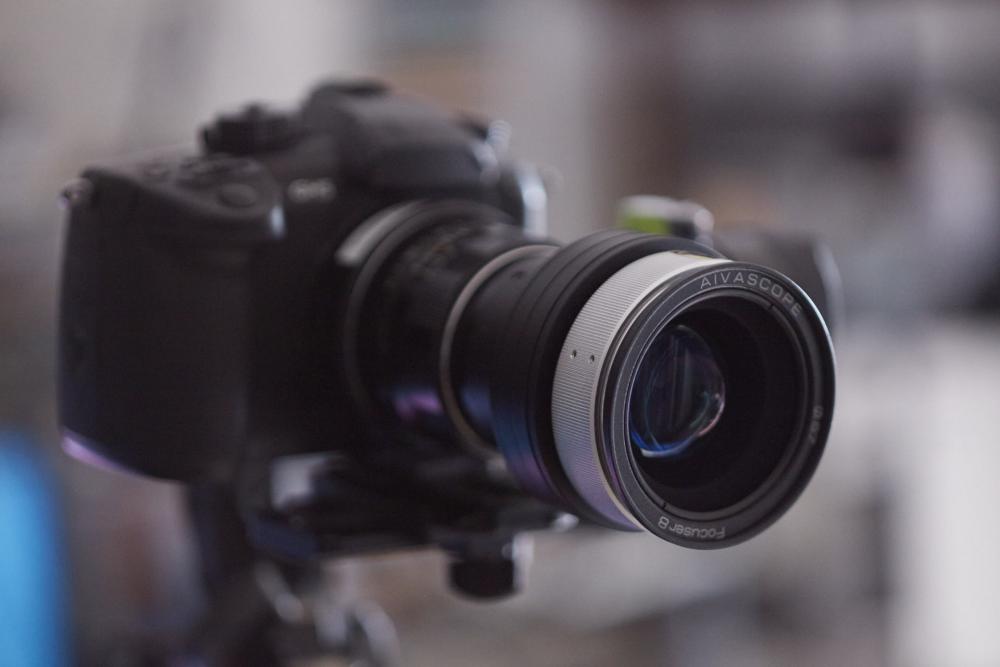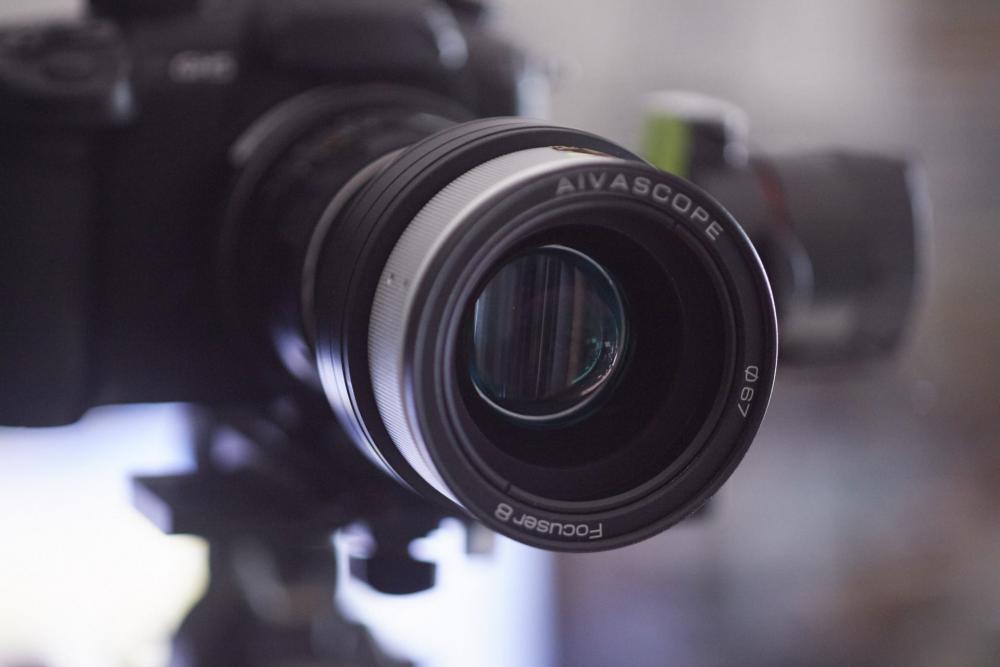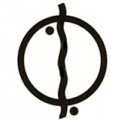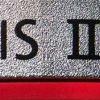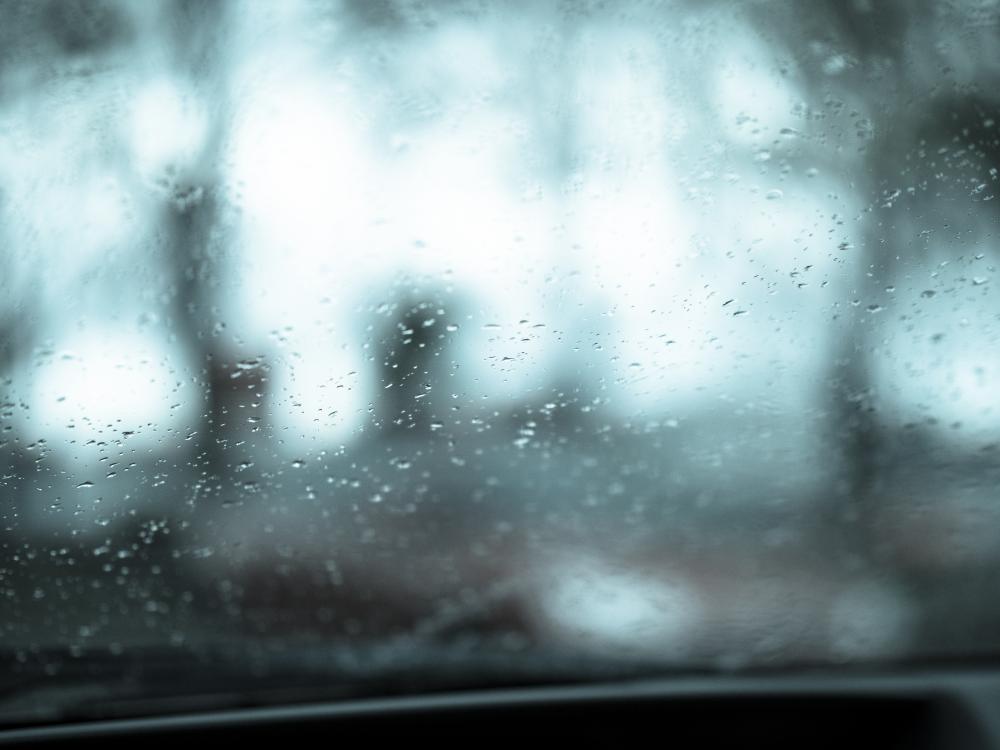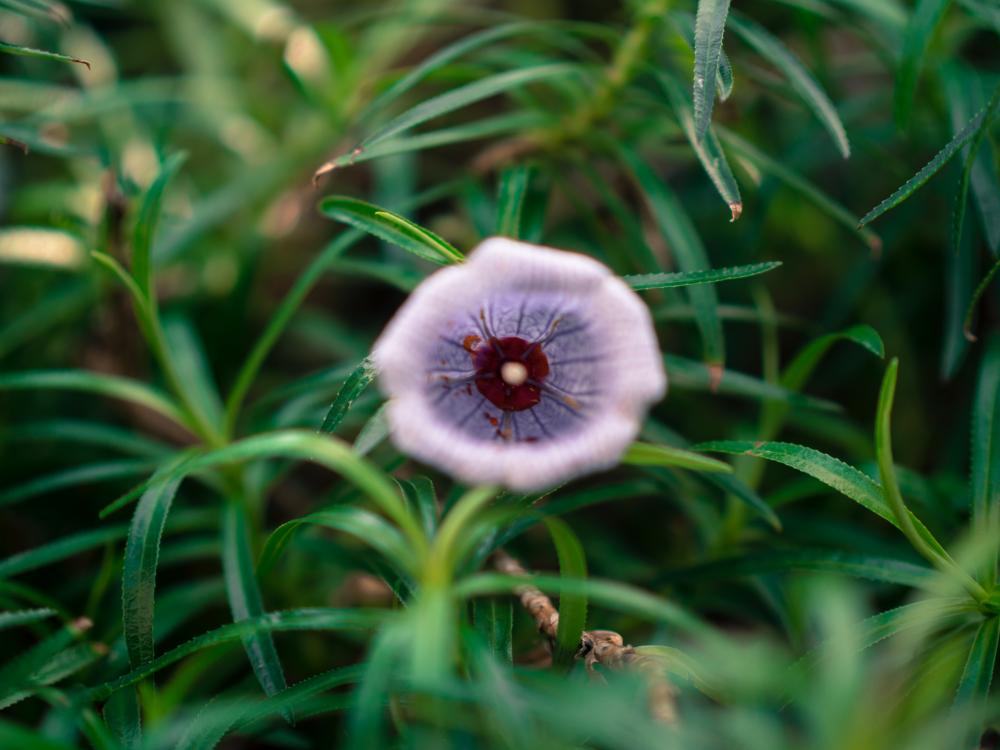Leaderboard
Popular Content
Showing content with the highest reputation on 06/11/2017 in all areas
-
So...... A bit of an update I've spent the past few days redoing this from the ground up and there's been what you might call 'a bit' of progress. The camera functions are now controlled by a gamepad, which gives a bit more scope in terms of buttons etc. By separating out the part that does the actual talking to the camera, this means that that can be smaller for mounting and the choice of the input device is now far more flexible as it can support pretty much any USB device that can be attached to it. In this version, the gamepad itself is wireless too so not only is it a lot neater but it can also be used to extend the overall distance of wireless control (its range to the control box is added to the range from the control box to the camera). I can also make it support multiple devices so you could have something smaller just to do basic control (or a USB numeric keypad would be quite good for that actually) and then use a more elaborate one when needed. Or do both simultaneously if you want control of exposure and someone else to do focus etc. Speaking of focus, this is now controlled by an analog stick so has a bit more feel to it (ignore the transitions in the video, the debug mode makes the control much coarser) with a press in the centre of the stick activating a one shot AF. If your camera has a powered zoom lens (hello LX100 etc) then this is controlled from the same stick by pushing forward and back. I believe that this will also work with those MFT lenses that support power zoom but I don't have one so I can't confirm that. I've made a drivable AF joystick point mode which you activate by pressing in on the right hand analog stick and then using the D Pad to drive the focus point around the screen and then pressing in the stick again to action it. There will be more focus enhancements coming......... The shutter speed and aperture are now controlled by the shoulder buttons on the gamepad and the ISO is now also directly switchable on two buttons. I've got a few more enhancements coming over the next few days as well so I'll keep you informed. In the meantime, here is a video of it controlling a GX805 points
-

Cheap vs Expensive Camera Blind Test
Cinegain and 3 others reacted to fuzzynormal for a topic
I like the idea of doing current work with my 'ol hacked GH1 and a chinese-speed-boosted 50mm. That's, what, $250 for all that? Kinda wish I still had that camera...or had the nerve to stop buying new stuff and just be creative with what I got.4 points -
So as I've hinted more than a few times in the other thread, the discovery of the Cinelike D and other bits and pieces for the GX80 etc was actually a bit of a happy accident while I was trying to do understand the Panasonic wifi stuff for something else. And here is that something else. Well at least a prototype of it but it is fully functioning and will just be finessed a bit more. Basically, its a wireless hardware remote for the G series cameras that operates over wifi and can currently control record start/stop, shutter speed as well as aperture and focus if you're using a native lens, including a single shot AF switch. For the non-Cinelike D cameras that can now be hacked to have Cinelike D there is also a dedicated button to toggle it on and off so you don't need to mess about with browsers and computers or smartphones anymore. Focus and aperture control are done on a joystick and everything else is switches. I'll be putting a layer switch on so that it can be toggled back and forth to a different control mode for ISO, WB and other stuff. As this is the prototype it is nowhere near the finished piece and it will be reduced in form factor to just be about the size of the control board. Power is by any USB source so there are billions of options. There is a lot more finessing and feature enhancement to go on with regard to the focus control (and yes, I know exactly what you'll all want it to do !) but the hard part is done now. It does support the display of the values on a screen and I'll be sorting some options out for that. The purpose of this gadget is primarily for use with a gimbal but it can also be really useful on a tripod bar for anyone shooting live event stuff. For cameras with inbuilt lenses I'm going to add a zoom mode on the joystick. A very quick very rough demo so you can see it in action. Any lag you might see between me operating the controller and the camera video is just a sync issue between me throwing the two recordings on very quickly3 points
-
Hey guys and gals, not sure how many people are filming abroad, but I thought that this might help when you need to keep the gear light!3 points
-

Sony A99 II so far, likes and dislikes
Aussie Ash and one other reacted to Andrew Reid for a topic
This camera is better in almost every way than the A7R II and A7S II. Lenses... I'll get onto those in a minute but A mount is nothing to be afraid of. Will be selling a lot of Canon glass after this and will end up actually saving money at the same time as increasing quality and decreasing weight. The AF is definitely better than the A7R II and kicks the A7S II into the dust. At F3.5 it tracks like a hawk. I can now see why Sony did this because at F1.4 on a softer lens it doesn't work nearly as well as Dual Pixel AF on the 1D X Mark II. But to have this bonus feature on the 24-70mm F2.8, losing just half a stop, but gaining amazing run & gun AF for video. The 1080/24p and 1080/120p are the SAME QUALITY. This makes the 1080/120p the best on the full frame camera market. The nicest ever. There's no crop, it's full frame. A7R II was 720p only and A7S II was a big 2x crop! What's more it is not just an S&Q mode but a fully continuous normal video mode with 5 axis IBIS and AF tracking, at 100Mbit. The S&Q mode is only 16Mbit. The 4K full frame quality is also very good but Super 35 does still have advantage in low light and to eliminate moire. Nice to have a top LCD for shooting info. A7 series lacks this of course. Buttons are better arranged than A7R II and A7S II. It is not laid out like a RX10 III. It is its own beast in terms of ergonomics. You can now assign Super 35mm mode to a button, which you can't on the mirrorless cams. The new menus are in there and do group stuff together better but they're not a big enough overhaul to make me really appreciate them. I try to go into the menus as little as possible. Unfortunately you can't assign 4K/1080p to a func. button or the func. menu, you have to dig into the menus when switching between 4K 24p and 1080/120fps. You can assign video recording to the exp. comp button next to shutter release, really handy. Default video button is better placed than A7 series but on the rear not the top. Exposure compensation can be assigned instead to rear or front dial when in A-priority mode, then it automatically reverts to shutter speed / aperture control in manual mode.... again super handy. The LCD can face forward for VLOGs and stuff, cannot do that with the A7 series or A9. It can also sit on top of the hotshoe almost (reminds me of Sony R1), or flips away to the base. More articulation options than the A7S II. AF for photos.... hmmm lovely. Super quick and reliable. The A lenses...TOP stuff. Particularly Zeiss 135mm F1.8, 50mm F1.4 and 24mm F2.0. The 85mm F1.4 is a bit noisy and slow for AF but great in MF. Super optically. The Zeiss 24-70mm F2.8 is like the G-Master lens, and just as big unfortunately. I prefer wherever possible the SSM lenses (24,50,24-70 but not 135 and 85) if using AF for video - much quieter internal focussing. I love the green indicator boxes in manual focus mode for video. Way less intrusive than peaking. It stops you from diving into the punch-in zoom mode or racking the focus ring back and forth a little bit to be sure. As soon as you get that green dot you can just stop and relax knowing that area is in focus. LOVE IT Have dialed EOSHD Pro Color into PP1. Looks WAY better than the default. Not tried S-LOG 3 to see if the banding is improved since A7S II yet. S-LOG 2 and S.Gamut Cine 3 with view assist all present like A7S II and an improvement over A7R II. 42MP stills and 18MP Super 35 mode. This for photography is significantly more in resolutions terms than the 1D X Mark II and allows you to effectively get two high quality prime lens focal lengths in one. The camera is more responsive than A7R II / A7S II. Starting / stopping video has zero lag. Start-up time very good. Writing the 42MP RAW+JPEG files - MUCH smoother. Max write speed is 60MB/s to UHS 1 cards. Dual card slots. Not Compact Flash speeds (80MB/s plus) on the card controller but much better than A7R II 30-40MB/s. This isn't a DSLR. EVF quality is very good, translucent mirror doesn't flip. It's instant-on like mirrorless camera. Body size and weight is similar to the GH5. So far far less than 1D X Mark II. Has a DC-IN port, but doesn't seem to take charge from USB. Battery is probably too big for 5v 2-amp charging. There's a very smooth and nice front dial near the lens release which is assignable to things like ISO... It can be clickless or clicking. Now the bad stuff... The LCD dims in movie mode when you're shooting 4K or 120fps 1080p. It's either a power management thing or a heat thing. Makes exposure look totally different and 2 stops darker than same settings in stills mode. Very silly Sony!!! It seems all unnecessary on this camera because of the bigger battery than A7 series. Although the screen does get very slightly warm at full brightness outdoors, to think this would contribute to overheating problems is unlikely and it can be flipped completely away from the back of the camera where the hot main board and chipsets back directly onto the rear casing with no proper heat sink (I've seen the tear-down photos). Sadly my camera came with a small faulty part... a sticky joystick in the 'right' direction. Apparently it 'wears-in' over time but I don't think mine is proper...why would it only need wearing-in to click right responsively and not also up/down/left? We'll see if my next unit does the same weirdness. On this point, I think Sony still have work to do to convince us they can make buttons. Can you imagine this on a pro body like a Canon 1D X Mark II? Journalists would be rabid, foaming at the mouth. That's it for now, can't actually use it much more as it has to go back to DigitalRev but plan to do the review soon. I think this is a real rival to the GH5... No 10bit but you gain full frame, better slow-mo, 42MP stills and maintain pretty much all the other features. That's it with the Zeiss 50mm F1.4 The Sony 35mm F1.4 G is also a nice one... forgot to mention that. It's much smaller and lighter than the Sigma ART 35mm. Size comparison with the GH5 Although lens mount makes the A99 II look much larger, the tops of the bodies are practically level (look at hot shoe and mode dials) The grip is a bit deeper on the A99 II and card door a lot wider... dual card slots on both.2 points -
Cheap vs Expensive Camera Blind Test
TrueIndigo and one other reacted to Mattias Burling for a topic
Just for the heck of it. Here is the same cameras doing what cameras do best.. pet pics Fuji XT2 Sigma DP2 Sigma SD Quattro (BTW click on this one and full ress. The colors.... yummy..)2 points -
Cheap vs Expensive Camera Blind Test
Aussie Ash and one other reacted to TrueIndigo for a topic
I also think the Panasonic G7 is an important low cost UHD camera. During the period when I was making decent money, I used to buy a new camera every year, as a personal exploration which I enjoyed. Last few years though I had to stop that, but strangely didn't miss it. I sold off a lot of stuff (currently down to five stills cameras and two camcorders) and spent more time exploring the cameras I already had, rather than exploring yet another camera. Because I really think we have been in the era of "good enough" for some time now. We can make a solid starting point for colour grading and using creative LUTs which can radically change the look of the final image anyway. I did lapse recently though, and got the G7 because there was a good deal going on it, presumably because it's now an outgoing model. At £380 for the body, I think it must be the cheapest new camera I've ever bought. After experimenting with various Mods to the Natural picture profile and Daylight white balance, I'm seeing an image not so different from the Nikons which I love. Way back I bought a GH1 when it first came out, so I still had a lot of MFT lens adapters and enjoy using my vintage Nikon AIS prime set. My main reason to buy it though (after a long time shooting video with DSLRs) was not so much about image, but a usability consideration: the opportunity to have a high res EVF for hand-held shooting (using a pistol grip to hold it to my eye). Feels like shooting Super 8 all over again, and I actually enjoy using this little camera. I think you can't underestimate how important the usability and pleasure of actually picking up a camera becomes, now that image quality is so good on almost everything.2 points -

Cheap vs Expensive Camera Blind Test
jase and one other reacted to Andrew Reid for a topic
Yeah it's fun. Cinema5D just said $8000 is Little Money for the C200, haha. I like your idea of cheapest premium camera you can find. $28? THAT is "Little Money"!! The Sigma DP1 is a really unique tool for colour, for pleasure and for art... slow, but so much going for it. I wish more people would cover the cheap cameras and hidden gems. Samsung NX1 was one as well. Most of those who bought it didn't feel need to go all out and blow $3000 on a Sony afterwards. My current tip for a bargain for 4K, art and sheer enjoyment is the GX85 with cinelikeD hack And for stills a $500 Sony A900 with $80 Minolta 24-105mm F3.5-4.5... Can't go wrong with that. Full frame and the lens has character... whilst being 1/7th of the price of the Sigma ART 24-105mm F4, almost as sharp and 1/4th of the size.2 points -

Two Things I've Learned - Shooting 16mm Glass on the Blackmagic MIcro
Kurtisso and one other reacted to Ed Andrews for a topic
This looks amazing. Really gets that super16 feel. I've been shooting a series of docs with bmmcc and zeiss 12-120. Here's one. It comes out a bit sharper than the Angeniuex but still love the whole combo with old s16 glass2 points -
Shot with the Blackmagic MIcro Cinema Camera with the Angeniuex 12-120mm 16mm lens, a cameflex mount modified to micro 4/3rds. For color, I brought into Da Vinci resolve and used Filmconvert with a Fuji Eterna film stock and softened it even more to Super16mm softness. Added a tiny bit of grain and that gave me a great starting point to harken back to a more organic look. I zoomed in digitally mostly around 20% - and it still was too sharp of an image. Why not shoot it anamorphic instead? Well, I am in love with documentaries of the 60s and 70s like Grey Gardens, etc. And they used this lens I think, and it has a certain feel to it that’s pretty beautiful. Let me know what you guys think of this.1 point
-
I'd take a look at the Fuji X-T20 and the 10-24mm F4 4K, can turn things round quick because of its OOC looks, light enough to mount on the Crane, A/B as a stills combo against a D800 and Nikon's 14-24 f2.8 and its not embarrassed in the slightest, you can put an ND on it without jumping through (expensive) hoops, the lens has IS, touch screen focus etc etc And you can put a lens turbo on it to use all of your Nikon lenses. I used the 14-24mm far more than you'd imagine a sports photographer might (stadium views, low ringside at boxing,in the melees after a trophy presentation etc) and the key word there is 'used' as its been put into retirement now by an X-T20 and 10-24mm for ALL of that stuff. Might not be the total answer to what you want (and by the wrestling you're having there probably isn't one) but its worthy of a look if you have a local camera store that stocks them. I could've saved myself a load of typing if I'd seen this first!!1 point
-
Definitely interested on getting one1 point
-
As soon as I've got everything on it that I want and settled on what I'm running it on I'll sort out a guide to how people can make one. It should be a matter of just buying a board and putting the software image on it then sorting yourself out for how to power it and getting a gamepad. Total cost for the bits you need to buy should be no more than about £45 even if you got for a wireless gamepad. There'll be a bit of a challenge sorting out an easily deployable software image that people can flash themselves but I'll sort that out over the next few weeks. Presuming anyone wants one that is of course.1 point
-
Cheap vs Expensive Camera Blind Test
Mattias Burling reacted to Fritz Pierre for a topic
Bought a GF1 for both my wife and my 20 year old daughter....they both love the camera and for stills while traveling, ridiculously good in such a small yet tank like package...IMO...a classic...at an unbeatable price!1 point -
Wow, super cool. When are you selling kits? *8^)1 point
-
Yup +10 for this thread. A few months ago, after I sold my GX85 and before I bought my 5D3, I was unsure what route to go, so I was just shooting with my humble D5500 and I found it liberating to try silly shots and experiment. I missed the GX85's 5-axis so much, I used my Benro monopod, the one with the swivel ball feet, and pressed it against my shoulder as a make shift shoulder rig. With that freedom, the low hanging sun of mid winter, 60p and a fast 35mm lens, I started walking around and shooting. This what I came up with... There was something interesting within the way the bokeh and the branches and the sunlight/shadows worked within the confines of D5500 slow motion... obviously it's just a little slow motion, who cares, but I found it pretty fun to push one of the cheapest cameras I have ever bought and I may be the only one, but I like what came from it. Disclaimer: it is long and possibly boring... so proceed with caution... ?1 point
-
Yup, still enjoy using it. Best point in this video is at 1:13 showing the lack of breathing and how it renders. Used it somewhat on my A7r II, but haven't posted video yet.1 point
-
Whats the rolling shutter like in S35?1 point
-
My GH5 Anamorphic Gimbal Setup
Dr. Verbel' reacted to NewFilmMaker for a topic
After trying so many different lenses (both anamorphic and taking lenses), I believe this is the best out of what I own....... Voitglander Classic 35mm F1.4 MC Bolex Moller 19/1,5x Raynox Wide Angle Conversion Lens 0.66x Zhiyun Crane Gimbal Version 2 Wide angle - Around 24mm View?? Image are sharp and it looks like that anything beyond 3ft are all in focus when I stop down to F4 Please let me know what you think and show me whats your setup!1 point -
OT: Panny, nice find. This guy's work is inspiring. Love his old GH3 video...1 point
-
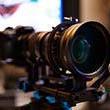
My GH5 Anamorphic Gimbal Setup
Ian Edward Weir reacted to nahua for a topic
1 point -
Nikon color science and Zeiss goodness making the older Nikon D4 shine. Should be even better on the D750 regarding resolution and much better regarding quality of codec. Anyway, why not get a Canon 1DC combining both: awesome color and good 4K resolution and the possibility to adapt some Zeiss glass in Contax Yashica mount or the Zeiss ZE lenses without adapters?1 point
-

Still Swimming with the big boys... Rated #9th 2017
Francesco Tasselli reacted to Marco Tecno for a topic
In 2015 I claimed that nx1 would have been relevant at least until 2020. I think my prophecy will prove true :-D1 point -
Next gig, next clip: This time OOC.1 point
-
Lenses
jase reacted to Fritz Pierre for a topic
Agreed...except one of the best aspects of that lens is the fact that it's a pancake....on a stabilized camera, you can be on any street corner grabbing stellar footage while attracting no more attention than a tourist!...huge value in that stealth factor for me...I've actually contemplated the 14mm 2.5 Panny pancake for this very reason...they are tiny and optically excellent for the price!1 point -

Cheap vs Expensive Camera Blind Test
Orangenz reacted to AaronChicago for a topic
I can't really say which frames are "better" or "worse" but I prefer 2.1 point -

Two Things I've Learned - Shooting 16mm Glass on the Blackmagic MIcro
Lintelfilm reacted to AaronChicago for a topic
There is just something about that BM Super 16 sensor that is magical. I look back at stuff that I shot with the Pocket and think "Damn that was one of my favorite looking videos."1 point -

Panasonic GH5 - all is revealed!
Gregormannschaft reacted to AaronChicago for a topic
I just listened to an hour long podcast with the DP of Fargo season 3. I've been really digging the look of the season. He gave some insight to his color profile, so I decided to make a LUT for V Log L based off of Fargo Season 3. By no means is it perfect but have fun: https://www.dropbox.com/s/gtpwt6gxczfnyrf/FargoSeason3VLogL.cube?dl=01 point -
nothing special, but i really like the cinelike d hack!1 point
-
There is no simple answer since video editing and codecs span a wide range. H264 1080p can be edited natively with good performance using either Premiere or FCPX on most machines. You don't need a top-end CPU or GPU for this. OTOH most H264 4k codecs are difficult to edit, even on top-end machines, and often require transcoding to proxy for smoothest editing. Exceptions are H264 4k codecs like Canon's XF-AVC Intra, that is very fast to edit. There can also be a big difference between (say) Premiere and FCPX, especially on a Mac. In general FCPX is considerably more responsive, especially for editing H264 4k. It is about 4x faster exporting to H264 since it uses Quick Sync and Premiere does not. However Premiere has gotten faster the last year or so, even without proxy, which it now also has. That's the editing; effects are different. No matter how lightweight the codec, a computationally-intensive effect must be calculated for each 4k frame. Effects can be implemented entirely in the CPU, entirely in the GPU or a mixture of both. Some effects like Neat Video allow CPU vs GPU rendering, a mix of both and how many CPU cores to use. In general 4k is really difficult to edit. From a CPU standpoint the more (and faster) cores the better. An i7 iMac can be significantly faster than an i5 iMac of the same generation because (1) the CPU clock is faster, and (2) hyperthreading. The current iMac 27 the i7 is about 11% faster just from clock speed. Benefit from hyperthreading varies widely. I used the 3rd party CPUSetter utility to disable/enable hyperthreading on an i7 iMac, and this made about 30% difference in FCPX export speed to H264. For other tasks such Lightroom import and preview generation, it made no difference. Re Radeon 580, I haven't see any good benchmarks yet. However only certain tasks are amenable to GPU acceleration, e.g, H264 encode/decode cannot be meaningfully accelerated. The core algorithm is inherently sequential and not amenable to applying hundreds of lightweight GPU threads. But in general software developers increasingly try to leverage the GPU where possible. You can't update the GPU in an iMac so I'd tend to get the fastest one available.1 point
-
1 point
-
I can lower the microphone levels by -10. This is still way too loud for the music during parties. When I put the limiter as well, then it is usually just fine. Still some small distortion here and there. With the GH3 and GH4, I could just leave the mic at -20 and lower the input levels, or even take the microphone out and record with the onboard mics. I remember I put the GH3 at -8 during loud music events and it was fine. Now with the GH5, it is recording so loud at -12 that I almost can't make out anymore which song has been recorded. Just a massive track full of distortion.1 point
-
Black Magic out of Focus
tupp reacted to Aussie Ash for a topic
Hi tupp, Thank you for your comments.I should have stated in the first post we never shoot this footage.Whilst watching it I came to the conclusion that I'm too obsessed with trying to shoot "in focus" and for a genre like this ,"vague focus" still captures the rythm,mood,arty colors,people enjoying themselves and the band. "All the "shoot-throughs" and CUs are great, but I have found that it is often beneficial to also have a full-length, clean, wide shot of the entire band from which to cut in and out."Yep there is hardly any footage of the band playing together as a group. Also found your post on "The Young Victoria"1 point -
Panasonic GH5 - all is revealed!
Cas1 reacted to Rinad Amir for a topic
1 point -
Thank you for the 2012 camera manual link. As you can see in the manual, cine-d is the most linear of the gamma types. A problem in this thread is Mercer using "highlight clipping" interchangeably with "highlight rolloff." Which is unfortunate. All this is clarified below. Summarised here for your reading pleasure. This is from a 2016 white paper discussing exposure. Panasonic White Paper on Exposure Levels Most video camera gamma curves are designed to replicate what-you-see-is-what-you-get when the footage is displayed on a video monitor. That’s convenient, but there are sacrifices made in the amount of dynamic range that can be preserved when using a conventional video gamma. Furthermore, video gammas are more linear in design [than vlog], and that means that more “bits” are allocated to storing the brightest stops, than are allocated to store the darkest stops. This can result in mushy shadows, and noise and banding in the shadows if you try to brighten them in post. Exposure is normally 70 IRE for skin tones, and 100 IRE for highlights. When shooting in REC 709 gamma, I’m used to setting my zebras at 70 and 100; I would expose for there to be just a little bit of 70-IRE zebras on the brightest highlights on Caucasian skin tones; then I would swap over to Zebra 2 (set to 100 IRE) to check for highlight clipping. Exposure for VlogL is 55 IRE for Caucasian skin tones, and 80 IRE for highlights. An individual channel might clip earlier than the zebras indicate so in some situations one might set the vlog-L highlight clipping to a little lower (75 IRE) to minimize possible individual chroma channel clipping. Exposure is a game between three things: · Noise in the shadows – all digital sensors show the most noise in the darkest areas. Under exposing and lifting in post will maximise noise. Raising ISO will also increase noise levels. · Retaining the highlights – decide between main subject vs highlights. Deciding which highlights might have to be sacrificed for exposing the main subject is difficult. In an ideal world no highlights will need to go past 100 – welcome to studio set lighting. · Maintaining consistent midtones between shots For a good read on basic ETTR principles and the balance http://www.leeminglutone.com/#howtoettr Hope you find this helpful.1 point
-
White papers are written by the people who designed the curve. They understand the best exposure methods to use so skin tones hit at the right place on the curve, so your highlights don't clip, etc... One of the reasons there was so much orange skin with the CineLikeD Profile, back in GH4/G7 days, was because everybody was exposing it to the left... of course they were also dropping contrast too. With most Log and Flat profiles you need to know where middle gray hits on the curve. Just exposing to the right doesn't give you that. Now if you're using Leeming LUT and his settings, you are probably good because Paul has done extensive research, but if you're not, it's best to nail your exposure in camera, or go slightly under and pull up. I don't have a Panny camera at the moment but I remember when I would ETTR, the footage was clipped on the RGB parade. Pulling it back didn't bring back that highlight information. But underexposing a 1/3 of a stop or hitting dead center and you could pull up the highs and still get some nice rolloff.1 point
-
So, I hope someone with some coding skills takes a look at BTM's finds to see if something more can be done. The GX85 or G85 would be epic with 200mbps 1080p.1 point
-
Kind of but its actually a lot more basic than that to be honest mate and doesn't require any modification of the app. I've got a really simple way of testing it if anyone wants to have a go themselves?1 point
-
All three were Cinelux WA, Canon 50mm 1.8, and a GH2. Very sharp, very crisp and defined flares. No longer own this and kind regret getting rid of it. Own a version 2 Hypergonar now, which in comparison has much less crisp but very long flares. I would say the Cinelux is more clinical and the Hypergonar more filmic and organic.1 point


